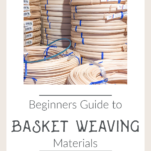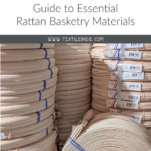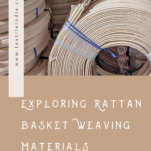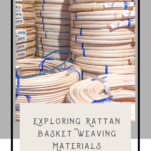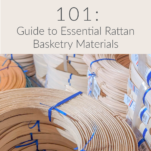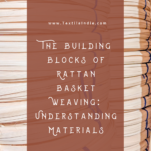This post contains affiliate links. I could be an affiliate for many different products, but I chose these specifically because they are the products and brands I like and recommend. By using my links, you help support this website.
For a complete guide to all Textile Indie’s basket weaving posts and videos, visit the main Basket Weaving Page.
What materials do you need to weave a basket?
There are many different basket-weaving styles and traditions in the world. Check out Beginners Guide to Basket Weaving for an overview of basket types and techniques.
Here at Textile Indie, we focus on baskets made from rattan plants. Rattan-based material is called basket reed. The pieces we’ll be weaving are made from the inner parts of the rattan vine.
Rattan is a vine that grows in Indonesia.
It is part of the palm family (genus Calamus). The vines are harvested into long lengths and processed into different shapes and widths.
You can find basket-weaving materials and tools at the Textile Indie Shop.
What is the most popular material in basket weaving?
Willow and bamboo are the most popular materials for basket weaving. Willow and bamboo are fast-growing, abundant sources of material.
Willow and bamboo baskets are prevalent in discount home and craft stores.
Other common materials are grasses, vines, and twigs. These three materials are widely available and free to gather in most parts of the world.
Basket weaving hobbyists lean toward rattan basket weaving. Although you can find materials, courses, and classes on any basket tradition, you’ll find the most support for rattan-style basketry.
In this post, I’ll refer to rattan basket weaving supplies as “reed.”
Reed types for basket weaving
Reed comes in a variety of sizes and types. Knowing these will help you understand basket pattern material lists. It will also enable you to design beautiful baskets because you know what is available.
Basket reed comes in five different types:

Flat reed
Flat reed is flat on both sides and approximately 1/16″ to 1/8″ thick.

Flat Reed
 Buy Now →
Buy Now → Buy Now →
Buy Now → Buy Now →
Buy Now → Buy Now →
Buy Now → Buy Now →
Buy Now →Flat-oval reed
Flat-oval reed is flat on one side and beveled on the other. At the center, the thickest part is approximately 1/16″ to 1/8″ thick.
If you put two pieces of flat-oval reed, flat sides together, you would create an oval.

Flat-Oval Reed
 Buy Now →
Buy Now → Buy Now →
Buy Now → Buy Now →
Buy Now →Oval-oval reed
Oval-oval reed is rounded on both sides.
Half-round reed
Half-round reed is round on one side and flat on the other. It differs from flat-oval reed because the curve of the round side on the half-round is much more pronounced. You would create a circle if you put two pieces of oval-oval reed, flat sides together.
Round reed
As the name implies, the round reed is a reed that’s been cut into a long cylinder. There are many different diameters available. See the sizing chart below.

Round Reed
 Buy Now →
Buy Now → Buy Now →
Buy Now → Buy Now →
Buy Now →Reed sizes
Reed types are identified by the width of the reed.
If a pattern calls for a 1/4″ flat reed, it means you will need a flat reed that is 1/4″ wide.
You can find flat reed and flat oval reed as wide as one inch and as narrow as 11/64 of an inch.
Flat reed, flat-oval reed, oval-oval reed, and half-round reed are all sold by width in fractions of an inch or millimeters.





Round reed sizes
Round reed is sized by millimeter and often sold by a number (example: #0, #1, #2…).
Round reed sizing chart:
| Reed number | Reed diameter (mm) |
| #0 round reed | 1.25 mm in diameter |
| #1 round reed | 1.75 mm in diameter |
| #2 round reed | 1.5 mm in diameter |
| #3 round reed | 2.25 mm in diameter |
| #4 round reed | 2.75 mm in diameter |
| #5 round reed | 3.5 mm in diameter |
| #6 round reed | 4.25 mm in diameter |
| #7 round reed | 5 mm in diameter |
| #8 round reed | 5.75 mm in diameter |
| #9 round reed | 6.25 mm in diameter |
| #10 round reed | 7.5 mm in diameter |
Seagrass
Another material that I like to use in my basket weaving is seagrass. This tightly twisted grass rope is used as an accent to the reed.
Seagrass is produced in several different sizes. It’s sold in millimeters or by a number (example: #0, #1, #2…).

Seagrass
 Buy Now →
Buy Now →Seagrass sizing chart:
| Seagrass size | Seagrass diameter (mm) |
| #0 seagrass | 2.25 – 2.75 mm |
| #1 seagrass | 3.0 – 3.5 mm |
| #2 seagrass | 3.5 – 4.0 mm |
| #3 seagrass | 4.5 – 5.0 mm |
| #5 seagrass | 6.5 mm |
Other materials used in basket weaving
Baskets can be made from a variety of materials. Don’t let the list above stop your imagination from working. The above are materials used to make baskets from reed. You can always experiment with new materials.
Other basket-making materials include wire, paper, yarn, branches, grass, or seaweed.
Here’s a video of my first try at making a pine needle basket:
Do you want the best resources, tools, and products for fiber artists?
Every other Friday, I send an email chock full of fiber craft inspiration for you to explore.
Each issue focuses on one fiber art skill – spinning, dyeing, basket weaving…
Basket Handles
Adding a handle to your basket adds to its usefulness and aesthetic.
There are many handles to choose from.
For more in-depth information on handles and handle resources, visit Beginners Guide to Basket Handles.

Handle types
D handles
A “D” handle is shaped like the letter ‘D.’
It is flat on three sides while curving around the fourth side.
‘D’ handles work great for market baskets.

D Handles
 Buy Now →
Buy Now → Buy Now →
Buy Now →Swing handles
A swing handle comes in multiple styles. A swing handle, well, swings!

Swing Handle

Swing D Handle 10″ Wide x 15″ Tall
Buy Now →
Wire Handle with Wood Grip – 8″
Buy Now →Hoops
Hoops are used in ribbed basketry as a rim and a handle. Use two hoops to create a framework to build a basket around.
Hoops
 Buy Now →
Buy Now → Buy Now →
Buy Now → Buy Now →
Buy Now →U handles
A “U” handle is a handle that is curved and open on the flat side.
These handles are tucked into the sides of baskets.
“U” handles are commonly used in a bushel basket.

Handle creation
As with materials for constructing the basket walls, you can create a variety of handles using creative materials.
Feel free to experiment with new ideas and supplies to create your handles.
For instance, you may curve a length of reed into a simple handle, as I did for this wall basket.
You can use found objects from nature, like branches or twisted vines.
Hardware stores carry doweling, pipe, and cabinet hardware.
Look at thrift stores for baskets and purses with interesting handles. You can dismantle and repurpose these.
Where to buy basket weaving materials
Textile Indie Shop – I aim to keep a supply of reed, basket tools, and basket kits available.
More basketry posts:
For a complete list of basket terminology:
For a complete guide to all Textile Indie’s basket weaving posts and videos, visit the main Basket Weaving Page.
Basketry Immersion: A Year-Long Journey
Check out Textile Indie’s self-paced basket program if you want to learn to weave beautiful baskets.
Twelve different basket designs with video and written instructional support to learn foundational basketry techniques.
Over the course of twelve months, you will receive one basket pattern and a video with supporting instructional material each month. Start at basket one and weave all twelve.














